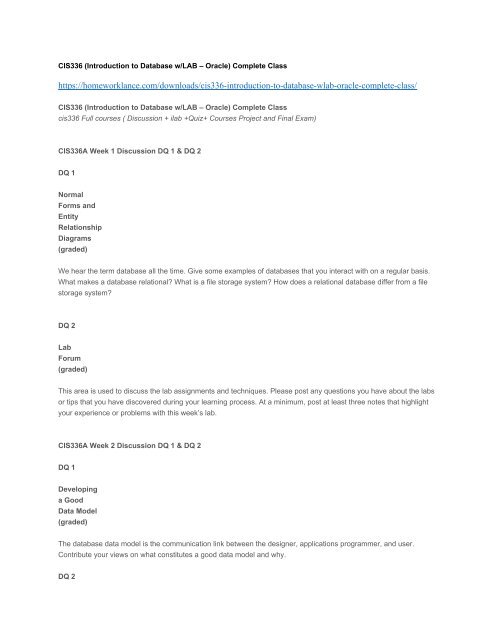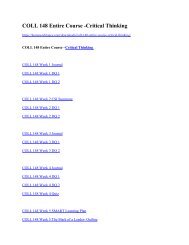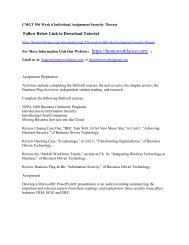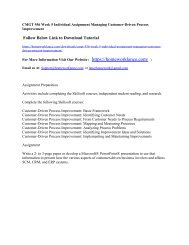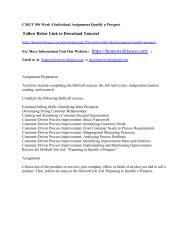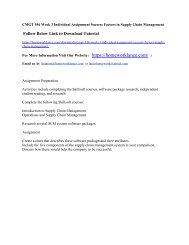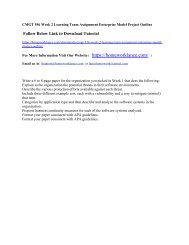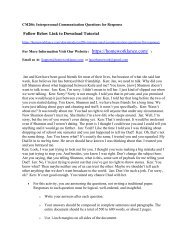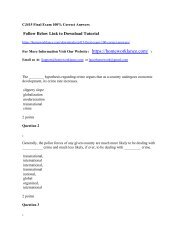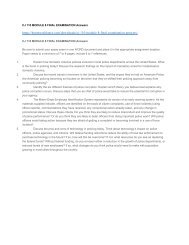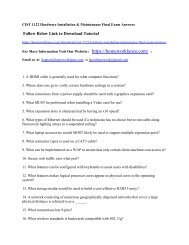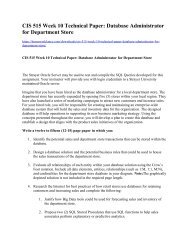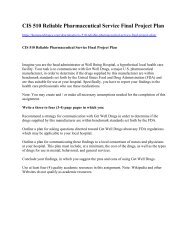Create successful ePaper yourself
Turn your PDF publications into a flip-book with our unique Google optimized e-Paper software.
<strong>CIS336</strong> (<strong>Introduction</strong> <strong>to</strong> <strong>Database</strong> w/LAB <strong>–</strong> <strong>Oracle</strong>) <strong>Complete</strong> <strong>Class</strong><br />
https://homeworklance.com/downloads/cis336-introduction-<strong>to</strong>-database-wlab-oracle-complete-class/<br />
<strong>CIS336</strong> (<strong>Introduction</strong> <strong>to</strong> <strong>Database</strong> w/LAB <strong>–</strong> <strong>Oracle</strong>) <strong>Complete</strong> <strong>Class</strong><br />
cis336 Full courses ( Discussion + ilab +Quiz+ Courses Project and Final Exam)<br />
<strong>CIS336</strong>A Week 1 Discussion DQ 1 & DQ 2<br />
DQ 1<br />
Normal<br />
Forms and<br />
Entity<br />
Relationship<br />
Diagrams<br />
(graded)<br />
We hear the term database all the time. Give some examples of databases that you interact with on a regular basis.<br />
What makes a database relational? What is a file s<strong>to</strong>rage system? How does a relational database differ from a file<br />
s<strong>to</strong>rage system?<br />
DQ 2<br />
Lab<br />
Forum<br />
(graded)<br />
This area is used <strong>to</strong> discuss the lab assignments and techniques. Please post any questions you have about the labs<br />
or tips that you have discovered during your learning process. At a minimum, post at least three notes that highlight<br />
your experience or problems with this week’s lab.<br />
<strong>CIS336</strong>A Week 2 Discussion DQ 1 & DQ 2<br />
DQ 1<br />
Developing<br />
a Good<br />
Data Model<br />
(graded)<br />
The database data model is the communication link between the designer, applications programmer, and user.<br />
Contribute your views on what constitutes a good data model and why.<br />
DQ 2
Lab<br />
Forum<br />
(graded)<br />
This area is used <strong>to</strong> discuss the lab assignments and techniques. Please post any questions you have about the labs<br />
or tips that you have discovered during your learning process. At a minimum, post at least three notes that highlight<br />
your experience or problems with this week’s lab.<br />
<strong>CIS336</strong>A Week 3 Discussion DQ 1 & DQ 2<br />
DQ 1<br />
Building<br />
the<br />
Physical<br />
Model<br />
(graded)<br />
What is the importance of constraints in a physical model? What role do different constraints play in maintaining<br />
referential integrity and data integrity?<br />
DQ 2<br />
Lab<br />
Forum<br />
(graded)<br />
This area is used <strong>to</strong> discuss the lab assignments and techniques. Please post any questions you have about the labs<br />
or tips that you have discovered during your learning process. At a minimum, post at least three notes that highlight<br />
your experience or problems with this week’s lab.<br />
<strong>CIS336</strong>A Week 4 Discussion DQ 1 & DQ 2<br />
DQ 1<br />
Understanding<br />
the SELECT<br />
statement<br />
(graded)<br />
Reports are generated using queries <strong>to</strong> a database. The SELECT statement is used <strong>to</strong> retrieve data from one or<br />
many tables in a database. Just as in other programming languages, understanding the syntax of a select statement<br />
is key. Let’s first discuss the key clauses in a SELECT statement and the purpose of each.
DQ 2<br />
Lab<br />
Forum<br />
(graded)<br />
This area is used <strong>to</strong> discuss the lab assignments and techniques. Please post any questions you have about the labs<br />
or tips that you have discovered during your learning process. At a minimum, post at least three notes that highlight<br />
your experience or problems with this week’s lab.<br />
<strong>CIS336</strong>A Week 5 Discussion DQ 1 & DQ 2<br />
DQ 1<br />
Getting<br />
Data<br />
From<br />
Multiple<br />
Tables<br />
(graded)<br />
It is not uncommon <strong>to</strong> have <strong>to</strong> retrieve data that resides in several tables, especially when formulating a report.<br />
Discuss some of the performance issues when querying three or four tables at a time.<br />
DQ 2<br />
Lab<br />
Forum<br />
(graded)<br />
This area is used <strong>to</strong> discuss the lab assignments and techniques. Please post any questions you have about the labs<br />
or tips that you have discovered during your learning process. At a minimum, post at least three notes that highlight<br />
your experience or problems with this week’s lab.<br />
<strong>CIS336</strong>A Week 6 Discussion DQ 1 & DQ 2<br />
DQ 1<br />
How<br />
Group<br />
Functions<br />
Differ
From<br />
Single-<br />
Row<br />
Functions<br />
(graded)<br />
What are some examples of group functions, and how do they differ from single-row functions?<br />
DQ 2<br />
Lab<br />
Forum<br />
(graded)<br />
This area is used <strong>to</strong> discuss the lab assignments and techniques. Please post any questions you have about the labs<br />
or tips that you have discovered during your learning process. At a minimum, post at least three notes that highlight<br />
your experience or problems with this week’s lab.<br />
<strong>CIS336</strong>A Week 7 Discussion DQ 1 & DQ 2<br />
DQ 1<br />
<strong>Database</strong><br />
Views<br />
(graded)<br />
What are the advantages of selecting data from a view over selecting data from a base table?<br />
DQ 2<br />
Lab<br />
Forum<br />
(graded)<br />
This area is used <strong>to</strong> discuss the lab assignments and techniques. Please post any questions you have about the labs<br />
or tips that you have discovered during your learning process. At a minimum, post at least three notes that highlight<br />
your experience or problems with this week’s lab.<br />
cis336 week ALL ilab<br />
devry cis336 week 1 ilab laest 2016 march<br />
iLab> Required Software<br />
Lab 1 of 7: Normal Forms and Entity Relationship Diagrams (xx points)<br />
Listen<br />
What’s this?<br />
iLab Overview<br />
Scenario/Summary<br />
Download the iLab instructions and the Answer Sheet for the necessary steps <strong>to</strong> be completed for this lab. They can<br />
be found below. You will notice that the readings, including lectures, the examples we worked on during the lecture,<br />
and other audio and visual aids provided, will help you tackle this week’s lab. Remember <strong>to</strong> always follow the<br />
instructions <strong>to</strong> get maximum credit, and use the weekly discussion related <strong>to</strong> the iLab and the Q & A Forum for<br />
additional help. Be specific and state the problem you are having clearly, including what you have done <strong>to</strong> resolve it,<br />
in the discussion.<br />
Microsoft Visio Tu<strong>to</strong>rial—Important Information<br />
Important: Before starting, be sure <strong>to</strong> review the Logical Modeling Part 1video under Video Library <strong>to</strong> familiarize<br />
you with how <strong>to</strong> use MS Visio <strong>to</strong> draw Entity Relationship Diagrams.<br />
Deliverables<br />
NOTE<br />
Submit your assignment <strong>to</strong> the Dropbox, located at the <strong>to</strong>p of this page. For instructions on how <strong>to</strong> use the Dropbox,<br />
read thesestep-by-step instructions.<br />
(See the Syllabus section “Due Dates for Assignments & Exams” for due dates.)<br />
The deliverable for this lab is a single MS Word document named lab1_solutions_yourname.docx with the answers<br />
included for Steps 1<strong>–</strong>4.<br />
Required Software<br />
Microsoft Office: Word and Visio 2010<br />
Use a personal copy or access the software athttps://lab.devry.edu.<br />
All Steps<br />
Lab Steps<br />
STEP 1: Download the Week 1 Lab Instructions<br />
Follow the instructions <strong>to</strong> complete the lab by downloading the following files:<br />
<strong>CIS336</strong>Lab1_Instructions.docx<br />
<strong>CIS336</strong>Lab1_StudentAnswerSheet.docx<br />
STEP 2: Submit Your Answers on the Lab 1 Student Answer Sheet<br />
Use Visio or Word <strong>to</strong> draw the dependency diagrams for Steps 1<strong>–</strong>3. Use Visio <strong>to</strong> draw the ERD for Step 4.<br />
This is the end of iLab #1<br />
devry cis336 week 2 ilab<br />
iLab> Lab Steps<br />
Lab 2 of 7: The Expanded Entity Relationship Diagram<br />
What’s this?<br />
iLab Overview<br />
Scenario/Summary<br />
Download the iLab instructions and the Answer Sheet for the necessary steps <strong>to</strong> be completed for this lab. They can<br />
be found below. You will notice that the readings, including lectures, the examples we worked on during the lecture,<br />
and other audio and visual aids provided, will help you tackle this week’s lab. Remember <strong>to</strong> always follow the<br />
instructions <strong>to</strong> get maximum credit, and use the weekly discussion related <strong>to</strong> the iLab and the Q & A Forum for
additional help. Be specific and state the problem you are having clearly, including what you have done <strong>to</strong> resolve it,<br />
in the discussion.<br />
Deliverables<br />
NOTE<br />
Submit your assignment <strong>to</strong> the Dropbox, located at the <strong>to</strong>p of this page. For instructions on how <strong>to</strong> use the Dropbox,<br />
read thesestep-by-step instructions.<br />
(See the Syllabus section “Due Dates for Assignments & Exams” for due dates.)<br />
The deliverable for this lab will be your completed ERD as a single MS Word document using copy/paste from the MS<br />
Visio application and namedlab2_solutions_yourname.docx<br />
Required Software<br />
Microsoft Office: Word<br />
Use a personal copy or access the software athttps://lab.devry.edu.<br />
All Steps<br />
Microsoft Office: Visio<br />
Use a personal copy or access the software athttps://lab.devry.edu.<br />
All Steps<br />
Lab Steps<br />
STEP 1: Download the Week 2 Lab Instructions.<br />
Follow the instructions <strong>to</strong> complete the lab by downloading the following files:<br />
<strong>CIS336</strong>Lab2_Instructions.docx<br />
STEP 2: Submit Your Answers<br />
Use Visio <strong>to</strong> create your ERD. Copy and paste <strong>to</strong> a Word document as indicated in the lab instructions.<br />
This is the end of lab #2<br />
devry cis336 week 3 ilab<br />
iLab> Lab Steps<br />
Lab 3 of 7: Building the Physical Model<br />
Listen<br />
What’s this?<br />
iLab Overview<br />
Scenario/Summary<br />
Beginning with this lab, and continuing through the remaining weeks you will be doing all of your work in the MySQL<br />
EDUPE Environment. By now you have received your logon ID and password and should have at least made sure<br />
you can connect. If for any reason you have not done so, please do so now before continuing any further. If for any<br />
reason you cannot connect, then you need <strong>to</strong> let the instruc<strong>to</strong>r know ASAP so that any problems can be resolved.<br />
In this lab you will transform a logical database design (data model) in<strong>to</strong> a physical model (tables, constraints, and<br />
relationships). Your job will be <strong>to</strong> take the relationship diagram along with the meta data defined in the data dictionary<br />
and define the table structures and constraints <strong>to</strong> create the physical tables. Once this has been done, you will<br />
populate the tables with data. Lastly, you will write SELECT statements <strong>to</strong> query the tables and verify the data was<br />
populated.<br />
Deliverables<br />
NOTE<br />
Submit your assignment <strong>to</strong> the Dropbox, located at the <strong>to</strong>p of this page. For instructions on how <strong>to</strong> use the Dropbox,<br />
read thesestep-by-step instructions.<br />
(See the Syllabus section “Due Dates for Assignments & Exams” for due dates.)
1. Your script file. Create this file in Notepad,notWord. Make sure your name is in a comment area at the <strong>to</strong>p of<br />
the script file. Use a double dash <strong>to</strong> create a one-line comment.<br />
—Jacob Smith<br />
—Lab 3<br />
Required Software<br />
MySQL<br />
Access the software athttps://devry.edupe.net:8300<br />
Lab Steps<br />
STEP 1: Download the Week 3 Lab Instructions<br />
<strong>Complete</strong> the lab by downloading the following files this week:<br />
<br />
<strong>CIS336</strong>Lab3_Instructions.docx<br />
<br />
<strong>CIS336</strong>Lab3_Files.zip<br />
STEP 2: Submit Your SQL Command File<br />
Use Notepad <strong>to</strong> write the SQL statements and submit according the lab instructions.<br />
This is the end of Lab #3<br />
devry cis336 week 4 ilab<br />
<br />
<br />
iLab> STEP 2: Download the Week 4 Lab Instructions and Answer Sheet<br />
Lab 4 of 7: Building the Physical Model<br />
Listen<br />
What’s this?<br />
iLab Overview<br />
Scenario/Summary<br />
Lab 4 will introduce the various aspects of the SQL SELECT statement and the methods of retrieving data from the<br />
database tables. The lab will utilize a database with a set of tables that you will create and populate using the<br />
instructions and script file found below. These tables will be used for the remaining labs in this class.<br />
Deliverables<br />
NOTE<br />
Submit your assignment <strong>to</strong> the Dropbox, located at the <strong>to</strong>p of this page. For instructions on how <strong>to</strong> use the Dropbox,<br />
read thesestep-by-step instructions.<br />
(See the Syllabus section “Due Dates for Assignments & Exams” for due dates.)<br />
The deliverable for this lab will include the following.<br />
The Student Answer Sheet file below provides a place for each query and the output of the query. You will<br />
copy and paste this information from your MySQL environment. Be sure your name, course number, and lab number<br />
are in your file which will be submitted <strong>to</strong> the iLab Dropbox for Week 4.<br />
Required Software<br />
Microsoft Office: Word<br />
Use a personal copy or access the software athttps://lab.devry.edu.<br />
All Steps<br />
MySQL<br />
Access the software athttps://devry.edupe.net:8300<br />
Lab Steps<br />
STEP 1: Create the <strong>Database</strong> and Tables<br />
Create the database and tables (that will be used in labs 4<strong>–</strong>7) by downloading the following files.<br />
CreateOMTables.docx(Instructions)
create_OM_db.sql(<strong>Database</strong> Script)<br />
STEP 2: Download the Week 4 Lab Instructions and Answer Sheet<br />
Follow the instructions <strong>to</strong> complete the lab by downloading the following files.<br />
<strong>CIS336</strong>Lab4_Instructions.docx<br />
<strong>CIS336</strong>Lab4_StudentAnswerSheet.docx<br />
Be sure <strong>to</strong> refer <strong>to</strong> the ERD for the database inOM_ERD.docxwhen creating your queries.<br />
STEP 3: Submit Your Answer sheet<br />
<strong>Complete</strong> the Answer Sheet <strong>to</strong> show your queries and results and submit according <strong>to</strong> the lab instructions.<br />
This is the end of Lab#4.<br />
devry cis336 week 5 ilab<br />
<br />
<br />
<br />
iLab> STEP 1: Download the Week 5 Lab Instructions and Answer Sheet<br />
Lab 5 of 7: Retrieving Data From Multiple Tables (39 points)<br />
Listen<br />
What’s this?<br />
iLab Overview<br />
Scenario/Summary<br />
Lab 5 deals with writing queries using multiple tables as covered in the reading and lecture material this week. In<br />
some cases, you will be given the option <strong>to</strong> choose the JOIN syntax <strong>to</strong> use, in other cases, you will be asked <strong>to</strong> take a<br />
specific approach. Using the incorrect process when the process is specified will result in points being taken off for<br />
that problem.<br />
Deliverables<br />
NOTE<br />
Submit your assignment <strong>to</strong> the Dropbox, located at the <strong>to</strong>p of this page. For instructions on how <strong>to</strong> use the Dropbox,<br />
read thesestep-by-step instructions.<br />
(See the Syllabus section “Due Dates for Assignments & Exams” for due dates.)<br />
The deliverable for this lab will include:<br />
The Student Answer Sheet file that you will download below provides a place for each query and the output of the<br />
query. You will copy and paste this information from your MySQL environment. Be sure your name, course number,<br />
and lab number are in your file which will be submitted <strong>to</strong> the iLab Dropbox for Week 5.<br />
Required Software<br />
Microsoft Office: Word<br />
Use a personal copy or access the software athttps://lab.devry.edu.<br />
All Steps<br />
MySQL<br />
Access the software athttps://devry.edupe.net:8300<br />
Lab Steps<br />
PRELIMINARY STEP: If You Have Not Created the <strong>Database</strong> Yet, Please <strong>Complete</strong>.<br />
This lab will utilize the tables that were created in Lab 4. If you have not yet created these tables,you can create the<br />
database and tables (used in labs 4<strong>–</strong>7) by downloading the following files.<br />
CreateOMTables.docx(Instructions)<br />
create_OM_db.sql(<strong>Database</strong> Script)<br />
STEP 1: Download the Week 5 Lab Instructions and Answer Sheet<br />
Follow the instructions <strong>to</strong> complete the lab by downloading the following files.<br />
<strong>CIS336</strong>Lab5_Instructions.docx
<strong>CIS336</strong>Lab5_StudentAnswerSheet.docx<br />
Be sure <strong>to</strong> refer <strong>to</strong> the ERD for the database inOM_ERD.docxwhen creating your queries.<br />
STEP 2: Submit Your Answer sheet<br />
<strong>Complete</strong> the Answer Sheet <strong>to</strong> show your queries and results and submit according <strong>to</strong> the lab instructions.<br />
This is the end of Lab #5.<br />
devry cis336 week 6 ilab<br />
<br />
<br />
<br />
<br />
iLab> STEP 1: Download the Week 6 Lab Instructions and Answer Sheet<br />
Lab 6 of 7: Group Functions and Subqueries<br />
Listen<br />
What’s this?<br />
iLab Overview<br />
Scenario/Summary<br />
Lab 6 will introduce group or aggregate functions and subqueries. Make sure <strong>to</strong> follow the instructions provided by<br />
each step.<br />
Deliverables<br />
NOTE<br />
Submit your assignment <strong>to</strong> the Dropbox, located at the <strong>to</strong>p of this page. For instructions on how <strong>to</strong> use the Dropbox,<br />
read thesestep-by-step instructions.<br />
(See the Syllabus section “Due Dates for Assignments & Exams” for due dates.)<br />
The deliverable for this lab will include the following.<br />
The Student Answer Sheet file that you will download below provides a place for each query and the output of the<br />
query. You will copy and paste this information from your MySQL environment. Be sure your name, course number,<br />
and lab number are in your file which will be submitted <strong>to</strong> the iLab Dropbox for Week 5.<br />
Required Software<br />
Microsoft Office: Word<br />
Use a personal copy or access the software athttps://lab.devry.edu.<br />
All Steps<br />
MySQL<br />
Access the software athttps://devry.edupe.net:8300<br />
Lab Steps<br />
PRELIMINARY STEP: If You Have Not Created the <strong>Database</strong> Yet, Please <strong>Complete</strong>.<br />
This lab will utilize the tables that were created in Lab 4. If you have not yet created these tables, you can create the<br />
database and tables (used in labs 4<strong>–</strong>7) by downloading the following files.<br />
CreateOMTables.docx (Instructions)<br />
create_OM_db.sql (<strong>Database</strong> Script)<br />
STEP 1: Download the Week 6 Lab Instructions and Answer Sheet<br />
Follow the instructions <strong>to</strong> complete the lab by downloading the following files.<br />
<strong>CIS336</strong>Lab6_Instructions.docx<br />
<strong>CIS336</strong>Lab6_StudentAnswerSheet.docx<br />
Be sure <strong>to</strong> refer <strong>to</strong> the ERD for the database inOM_ERD.docx when creating your queries.<br />
STEP 2: Submit Your Answer Sheet<br />
<strong>Complete</strong> the answer sheet <strong>to</strong> show your queries and results, and submit according <strong>to</strong> the lab instructions.<br />
This is the end of Lab #6
Devry <strong>CIS336</strong> All Week Quiz<br />
Devry <strong>CIS336</strong> Week 2 Quiz Latest 2016 March<br />
Devry <strong>CIS336</strong> Week 2 Quiz Latest<br />
Question 1. Question : (TCO 2) Which statement is FALSE regarding a primary key?<br />
Only parent tables must have a primary key.<br />
The values must be unique.<br />
It can be made up of multiple attributes.<br />
The value cannot be NULL.<br />
Question 2. Question : (TCO 2) _____ integrity insures that the value of a foreign key must match a primary key<br />
value in the table <strong>to</strong> which it is related, or be null.<br />
Referential<br />
Entity<br />
Data<br />
Logical<br />
Question 3. Question : (TCO 2) A verb associating two nouns in a business rule usually translates <strong>to</strong> a(n) ____ in<br />
the data model.<br />
entity<br />
attribute<br />
relationship<br />
constraint<br />
Question 4. Question : (TCO 4) A(n) _____ provides a graphical description of a data model.<br />
entity relationship diagram<br />
data dictionary<br />
business rule<br />
pseudocode<br />
Question 5. Question : (TCO 2) A _____ primary key is made up of more than one attribute.<br />
composite<br />
foreign<br />
bridge<br />
linking<br />
Question 6. Question : (TCO 4) In the figure below, the OrderLineItems entity is there <strong>to</strong> implement what type of<br />
relationship between Orders and Products?<br />
One <strong>to</strong> one<br />
One <strong>to</strong> many<br />
Many <strong>to</strong> many
No relationship<br />
Question 7. Question : (TCO 2) When designing a database, you should _____.<br />
make sure entities are in normal form before table structures are created<br />
create table structures then normalize the database<br />
only normalize the database when performance problems occur<br />
consider more important issues, such as performance, before normalizing<br />
Question 8. Question : (TCO 2) A table that is in 1NF and includes no partial dependencies only is said <strong>to</strong> be in<br />
_____.<br />
1NF<br />
2NF<br />
3NF<br />
BCNF<br />
Question 9. Question : (TCO 2) A table is not in 1NF if _____.<br />
it has a primary key defined<br />
all of the key attributes are defined<br />
there are repeating groups in the table<br />
all attributes are dependent on the primary key<br />
Question 10. Question : (TCO 2) Entity attributes and primary keys are not present in the _____ data model.<br />
logical<br />
physical<br />
conceptual<br />
network<br />
Devry <strong>CIS336</strong> Week 3 Quiz<br />
Devry <strong>CIS336</strong> Week 3 Quiz Latest 2016 March<br />
1. Question : (TCO 3) The _____ column attribute will au<strong>to</strong>matically generate unique numbers in sequence.<br />
DEFAULT<br />
AUTO_INCREMENT<br />
AUTO_SEQUENCE<br />
NOT NULL<br />
Question 2. Question : (TCO 5) The _____ keyword is used in an ALTER statement <strong>to</strong> remove a column from an<br />
existing table.<br />
MODIFY COLUMN<br />
ADD COLUMN<br />
DELETE COLUMN<br />
DROP COLUMN<br />
Question 3. Question : (TCO 3) Which uses the least amount of s<strong>to</strong>rage?<br />
“Example” s<strong>to</strong>red in a column of type CHAR(20)<br />
“Exam” s<strong>to</strong>red in a column of type CHAR(20)
“Ex” s<strong>to</strong>red in a column of type CHAR(20)<br />
They all use the same amount of s<strong>to</strong>rage.<br />
Question 4. Question : (TCO 3) The TIME data type in MySQL can s<strong>to</strong>re _____.<br />
dates only<br />
times only<br />
dates and times<br />
None of the above<br />
Question 5. Question : (TCO 3) Which statement is false regarding the creation of a foreign key constraint at table<br />
level or with an ALTER statement?<br />
The parent table must already exist.<br />
The field must already be defined in the table.<br />
The PK and FK fields must have the same name.<br />
The PK and FK fields may have different names.<br />
Question 6. Question : (TCO 3) A foreign key constraint can only reference a column in another table that has been<br />
assigned a(n) _____ constraint.<br />
NOT NULL<br />
UNIQUE<br />
PRIMARY KEY<br />
DEFAULT<br />
Question 7. Question : (TCO 3) You are creating a table called Department, with fields for the primary key DeptID<br />
(Integer) and department name (VARCHAR). What (if anything) is wrong with the following code?<br />
CREATE TABLE Department<br />
(<br />
deptID Primary Key INTEGER ,<br />
deptName NOT NULL VARCHAR(10)<br />
);<br />
You must use curly braces, not parentheses.<br />
The data type must immediately follow the field name.<br />
The keywords cannot be in upper case.<br />
Nothing is wrong.<br />
Question 8. Question : (TCO 3) What datatype is best <strong>to</strong> s<strong>to</strong>re a person’s age?<br />
INTEGER<br />
VARCHAR<br />
DECIMAL<br />
FLOAT<br />
Question 9. Question : (TCO 5) Which statement will remove the field STATUS from the CUSTOMERS table?<br />
ALTER TABLE cus<strong>to</strong>mers REMOVE status;<br />
ALTER TABLE cus<strong>to</strong>mers DROP status;<br />
ALTER TABLE cus<strong>to</strong>mers DROP COLUMN status;<br />
ALTER TABLE cus<strong>to</strong>mers DELETE status;<br />
Question 10. Question : (TCO 8) When you write an INSERT statement with a column list, which columns can be<br />
omitted from the column list?
AUTO_INCREMENT only<br />
DEFAULT only<br />
NOT NULL only<br />
AUTO_INCREMENT, DEFAULT, and fields that allow NULL<br />
Devry <strong>CIS336</strong> Week 4 Quiz Latest<br />
Devry <strong>CIS336</strong> Week 4 Quiz Latest 2016 March<br />
Question 1. Question : (TCO 6) To retrieve all fields from a table, use<br />
SELECT ALL.<br />
SELECT ANY.<br />
SELECT ().<br />
SELECT *.<br />
Question 2. Question : (TCO 6) Which opera<strong>to</strong>r would be most appropriate <strong>to</strong> determine books with a retail price in<br />
the range of $50 <strong>to</strong> $100?<br />
LIKE<br />
IN<br />
BETWEEN<br />
><br />
Question 3. Question : (TCO 6) Which code returns the date field HIREDATE in the format: Friday, April 5th, 2015?<br />
DATE_FORMAT(HIREDATE, ‘%W, %m %d, %Y’)<br />
DATE_FORMAT(HIREDATE, ‘%a, %M %D, %Y’)<br />
DATE_FORMAT(HIREDATE, ‘%W, %M %D, %Y’)<br />
DATE_FORMAT(HIREDATE, ‘%a, %m %d, %y’)<br />
Question 4. Question : (TCO 6) Given a cus<strong>to</strong>mer table with fields for firstname and lastname, which of the following<br />
will display the cus<strong>to</strong>mer name as a single field in the format “Jones, Tom” with a heading?<br />
SELECT CONCAT(lastname, firstname) as “Name” FROM cus<strong>to</strong>mer;<br />
SELECT CONCAT(firstname, lastname) as “Name” FROM cus<strong>to</strong>mer;<br />
SELECT CONCAT(lastname, ‘, ‘, firstname) as “Name” FROM cus<strong>to</strong>mer;<br />
SELECT CONCAT lastname ‘, ‘ firstname as “Name” FROM cus<strong>to</strong>mer;<br />
Question 5. Question : (TCO 8) The column <strong>to</strong> be updated by the UPDATE command is specified in the _____<br />
clause.<br />
WHERE<br />
MODIFY<br />
ALTER<br />
SET<br />
Question 6. Question : (TCO 6) Given a table orders with fields for orderid, orderdate, and shipdate, which query<br />
will display the ordered for only those orders that have not shipped?<br />
SELECT orderid FROM orders WHERE shipdate = orderdate;<br />
SELECT orderid FROM orders WHERE shipdate IS NOT NULL;
SELECT orderid FROM orders WHERE shipdate IS NULL;<br />
SELECT orderid FROM orders;<br />
Question 7. Question : (TCO 6) Which WHERE clause will return data on all employees with a last name beginning<br />
with ‘S’?<br />
WHERE lastname = ‘S’<br />
WHERE lastname = ‘S%’<br />
WHERE lastname LIKE ‘S’<br />
WHERE lastname LIKE ‘S%’<br />
Question 8. Question : (TCO 6) Given a books table with fields of title, cost, and retail, what if anything is wrong with<br />
the following query (assuming all fields exist)?<br />
SELECT * FROM books WHERE cost > 20 ORDER BY retail;<br />
You must sort and filter on the same field.<br />
You cannot use ORDER BY and WHERE in the same query.<br />
The WHERE clause must always be last.<br />
Nothing is wrong.<br />
Question 9. Question : (TCO 8) You can delete one or more rows in a table by using the _____ command.<br />
UPDATE<br />
DROP<br />
DELETE<br />
ALTER<br />
Question 10. Question : (TCO 6) Given a books table with fields: title, category (such as ‘SPORTS’), cost, retail;<br />
what condition will return ‘COMPUTER’ books with a retail price between $50 and $100 ?<br />
WHERE retail > 50 AND < 100 AND category = ‘COMPUTER’<br />
WHERE category = ‘COMPUTER’ AND (retail BETWEEN 100 and 50)<br />
WHERE category = ‘COMPUTER’ AND retail < 50 AND retail > 100<br />
WHERE category = ‘COMPUTER’ AND ( retail BETWEEN 50 AND 100)<br />
Devry <strong>CIS336</strong> Week 5 Quiz<br />
Devry <strong>CIS336</strong> Week 5 Quiz Latest 2016 March<br />
1. Question : (TCO 7) The implicit inner join syntax is defined as _____.<br />
NATURAL JOIN<br />
JOIN ON<br />
JOIN USING<br />
WHERE clause<br />
Question 2. Question : (TCO 7) To join four tables would require _____ join conditions.<br />
4<br />
3<br />
2<br />
Cannot tell without an ERD.
Question 3. Question : (TCO 7) Given the two tables described below, which of the following JOIN queries (if any) is<br />
not correct?<br />
cus<strong>to</strong>mer: with the fields cus<strong>to</strong>merid(PK), lastname, firstname<br />
order: with the fields orderid(PK), orderdate, cus<strong>to</strong>merid(FK)<br />
SELECT lastname, orderdate from cus<strong>to</strong>mer JOIN order ON cus<strong>to</strong>mer.cus<strong>to</strong>merid = order.cus<strong>to</strong>merid;<br />
SELECT lastname, orderdate from cus<strong>to</strong>mer JOIN order USING (cus<strong>to</strong>merid);<br />
SELECT lastname, orderdate from cus<strong>to</strong>mer, orders;<br />
All of the above<br />
Question 4. Question : (TCO 7) In a join, column names need <strong>to</strong> be qualified only<br />
in inner joins.<br />
in outer joins.<br />
when the code is confusing.<br />
when the same column names exist in both tables.<br />
Question 5. Question : (TCO 7) A left join returns<br />
rows in the left table that don’t satisfy the join condition.<br />
unmatched rows from both the left and right tables.<br />
rows in the right table that don’t satisfy the join condition.<br />
the Cartesian product of the two tables.<br />
Question 6. Question : (TCO 7) When you use the USING keyword for a join<br />
the join cannot be an outer join.<br />
the join cannot be based on more than one column.<br />
the join must be based on a column or columns that have the same name in both tables.<br />
the join must be an inner join.<br />
Question 7. Question : (TCO 7) Consider the ERD below. How many tables would be required <strong>to</strong> create a query <strong>to</strong><br />
display the cus<strong>to</strong>mer first and last name along with orderdate of each order they placed?<br />
One<br />
Two<br />
Three<br />
Four<br />
Question 8. Question : (TCO 7) Consider the ERD below. What tables will be needed <strong>to</strong> create a report showing the<br />
firstname and lastname of cus<strong>to</strong>mers who have placed an order for any product with keyboard in the description?<br />
cus<strong>to</strong>mer, product only<br />
cus<strong>to</strong>mer, order, product only<br />
cus<strong>to</strong>mer, orderline only<br />
cus<strong>to</strong>mer, order, orderline, product<br />
Question 9. Question : (TCO 7) Consider the ERD below. What tables will be needed <strong>to</strong> create a report showing<br />
cus<strong>to</strong>mer first and last name along with order date? The report should show all cus<strong>to</strong>mers even if they have never<br />
placed an order.<br />
SELECT firstname, lastname, orderdate from cus<strong>to</strong>mer LEFT JOIN order;<br />
SELECT firstname, lastname, orderdate FROM cus<strong>to</strong>mer RIGHT JOIN order ON cus<strong>to</strong>mer.cus<strong>to</strong>merid =<br />
order.cus<strong>to</strong>merid;<br />
SELECT firstname, lastname, orderdate FROM cus<strong>to</strong>mer JOIN order USING (cus<strong>to</strong>merID);
SELECT firstname, lastname, orderdate FROM cus<strong>to</strong>mer LEFT JOIN order ON cus<strong>to</strong>mer.cus<strong>to</strong>merid =<br />
order.cus<strong>to</strong>merid;<br />
Question 10. Question : (TCO 7) Consider the ERD below. Note that there are some products produced in-house<br />
that do not require a vendor, thus their vendorID is NULL. Also note that not all vendors currently supply products.<br />
Which query would be used <strong>to</strong> generate a report showing vendorname and productname, and will include ALL<br />
vendors even if they do not currently supply any products?<br />
SELECT vendorname, productname FROM vendor LEFT JOIN product;<br />
SELECT vendorname, productname FROM vendor RIGHT JOIN product;<br />
SELECT vendorname, productname FROM vendor LEFT JOIN product ON vendor.vendorID = product.vendorID;<br />
SELECT vendorname, productname FROM vendor RIGHT JOIN product ON vendor.vendorID = product.vendorID;<br />
Devry <strong>CIS336</strong> Week 6 Quiz<br />
Devry <strong>CIS336</strong> Week 6 Quiz Latest 2016 March<br />
1. Question : (TCO 7) Which is NOT an aggregate function?<br />
SUM<br />
COUNT<br />
ROUND<br />
MAX<br />
Question 2. Question : (TCO 7) Which of the following statements is correct?<br />
WHERE operates on groups formed by aggregate functions and HAVING operates on individual rows.<br />
WHERE can only be used along with HAVING.<br />
HAVING can only be used along with WHERE.<br />
WHERE operates on individual rows and HAVING operates on groups formed by aggregate functions.<br />
Question 3. Question : (TCO 7) Given the books table described below, which of the following will display the date<br />
of the book with the earliest publication date?<br />
books: bookid(PK), ISBN, title, pubdate, cost, retail, category, pubid(FK)<br />
SELECT MIN(pubdate) FROM books;<br />
SELECT title FROM books WHERE pubdate = MIN(pubdate);<br />
SELECT title FROM books WHERE pubdate < MIN(pubdate);<br />
SELECT pubdate from books WHERE MIN(pubdate) IS NOT NULL;<br />
Question 4. Question : (TCO 7) Given the books table described below, which of the following will display the title<br />
and retail price of books that are priced higher than the average retail price of all books?<br />
books: bookid(PK), ISBN, title, pubdate, cost, retail, category, pubid(FK)<br />
SELECT title, retail FROm books WHERE retail IN (SELECT AVG(retail) FROM books);<br />
SELECT title, retail FROM books WHERE retail > (SELECT AVG(retail) FROM books);<br />
SELECT title, retail FROM books WHERE retail > AVG(retail);<br />
SELECT title, AVG(retail) FROM books;
Question 5. Question : (TCO 7) Which of the values listed below can be returned by a subquery referenced as<br />
follows?<br />
WHERE vendorid = (subquery)<br />
A single value<br />
A column of one or more rows<br />
A table<br />
A subquery can’t be used in this way.<br />
Question 6. Question : (TCO 7) What type of subquery is executed once for each row processed by the main<br />
query?<br />
Correlated<br />
Uncorrelated<br />
Inner<br />
Outer<br />
Question 7. Question : (TCO 7) Given the two tables described below, which of the following queries will display the<br />
names of the cus<strong>to</strong>mers with orders shipped after December 1, 2014?<br />
cus<strong>to</strong>mer: with the fields cus<strong>to</strong>merid(PK), lastname, firstname<br />
order: with the fields orderid(PK), orderdate, shipdate, cus<strong>to</strong>merid(FK)<br />
SELECT lastname, firstname FROM cus<strong>to</strong>mer WHERE cus<strong>to</strong>merid = (SELECT cus<strong>to</strong>merID FROM order WHERE<br />
shipdate > ‘2014-01-12’);<br />
SELECT lastname, firstname FROM cus<strong>to</strong>mer WHERE cus<strong>to</strong>merid = (SELECT cus<strong>to</strong>merID FROM order WHERE<br />
shipdate < ‘2014-01-12’);<br />
SELECT lastname, firstname FROM cus<strong>to</strong>mer WHERE cus<strong>to</strong>merid = (SELECT cus<strong>to</strong>merID FROM order WHERE<br />
shipdate > ‘2014-12-01’);<br />
SELECT lastname, firstname FROM cus<strong>to</strong>mer WHERE cus<strong>to</strong>merid = (SELECT cus<strong>to</strong>merID FROM order WHERE<br />
shipdate < ‘2014-12-01’);<br />
Question 8. Question : (TCO 7) Given the two tables described below, which of the following queries will display<br />
each cus<strong>to</strong>merid along with the number of orders placed by that cus<strong>to</strong>mer?<br />
cus<strong>to</strong>mer: with the fields cus<strong>to</strong>merid(PK), lastname, firstname<br />
order: with the fields orderid(PK), orderdate, shipdate, cus<strong>to</strong>merid(FK)<br />
SELECT cus<strong>to</strong>merid, COUNT(cus<strong>to</strong>merid) FROM order;<br />
SELECT cus<strong>to</strong>merid, COUNT(ordered) FROM order;<br />
SELECT cus<strong>to</strong>merid, COUNT(orderid) FROM order GROUP BY cus<strong>to</strong>merid;<br />
SELECT cus<strong>to</strong>merid, COUNT(orderid) FROM order GROUP BY orderid;<br />
Question 9. Question : (TCO 7) Given the books table described below, which of the following will display each<br />
category along with the average retail price of books in that category?<br />
books: bookid(PK), ISBN, title, pubdate, cost, retail, category, pubid(FK)<br />
SELECT AVG(retail) FROM books;<br />
SELECT category, AVG(retail) FROM books GROUP BY category:<br />
SELECT category, AVG(retail) FROM books HAVING category;<br />
SELECT category, SUM(retail) FROM books GROUP BY category;<br />
Question 10. Question : (TCO 7) The expression below will be TRUE for what values of x?<br />
x > ALL(5, 9)<br />
5 and below
5 <strong>to</strong> 9<br />
5 and above<br />
9 and above<br />
Devry <strong>CIS336</strong> Final Exam answers<br />
Week 8 : Wk8 <strong>–</strong> Final Exam<br />
Top of Form<br />
Bot<strong>to</strong>m of Form<br />
Multiple Choice<br />
Question<br />
1. 1. (TCO<br />
1) A<br />
DBMS<br />
performs<br />
several<br />
important<br />
functions<br />
that<br />
guarantee<br />
the<br />
integrity<br />
and<br />
consistency<br />
of the data<br />
in the<br />
database.<br />
Which of<br />
the<br />
following<br />
is NOT one<br />
of those<br />
functions?<br />
(Points : 4)<br />
Multiuser access control<br />
Data integrity management<br />
<strong>Database</strong> access languages<br />
End of month reports<br />
Question<br />
2. 2. (TCO<br />
1) A<br />
relational<br />
DBMS<br />
provides
protection<br />
of the<br />
_____<br />
through<br />
security,<br />
control,<br />
and<br />
recovery<br />
facilities.<br />
(Points :<br />
4)<br />
user<br />
network<br />
system<br />
database<br />
Question<br />
3. 3. (TCO<br />
2) A<br />
relationship<br />
is an<br />
association<br />
between<br />
_____<br />
(Points : 4)<br />
objects.<br />
entities.<br />
databases.<br />
fields.<br />
Question<br />
4. 4. (TCO<br />
2) A<br />
_____ key<br />
is a key<br />
that is<br />
composed<br />
of more<br />
than one<br />
attribute.<br />
(Points :<br />
4)<br />
primary<br />
foreign<br />
composite<br />
domain<br />
Question<br />
5. 5. (TCO
3) The PK<br />
must<br />
uniquely<br />
identify<br />
each entity<br />
instance.<br />
A primary<br />
key must<br />
be able <strong>to</strong><br />
guarantee<br />
unique<br />
values. It<br />
cannot<br />
contain<br />
nulls. This<br />
rationale<br />
belongs <strong>to</strong><br />
_____<br />
(Points :<br />
4)<br />
unique values.<br />
nonintelligent.<br />
preferably single-attribute.<br />
security complaint.<br />
Question<br />
6. 6. (TCO<br />
3) The<br />
extended<br />
entity<br />
relationship<br />
model<br />
(EERM) is<br />
sometimes<br />
referred <strong>to</strong><br />
as the<br />
_____<br />
(Points : 4)<br />
entity relationship model.<br />
enhanced entity relationship model.<br />
entity clustering relationship model.<br />
extended entity relationship doctrine.<br />
Question<br />
7. 7. (TCO<br />
3) A table<br />
that has all<br />
key<br />
attributes<br />
defined,
has no<br />
repeating<br />
groups,<br />
and all its<br />
attributes<br />
are<br />
dependent<br />
on the<br />
primary<br />
key, is<br />
said <strong>to</strong> be<br />
in _____<br />
(Points :<br />
4)<br />
1NF.<br />
2NF.<br />
3NF.<br />
4NF.<br />
BCNF.<br />
Question<br />
8. 8. (TCO<br />
4) When a<br />
constraint<br />
is created<br />
at the<br />
_____<br />
level with<br />
the<br />
CREATE<br />
TABLE<br />
command,<br />
the<br />
constraint<br />
definition<br />
is simply<br />
included<br />
as part of<br />
the<br />
column<br />
definition.<br />
(Points :<br />
4)<br />
table<br />
column<br />
database<br />
row
Top of Form<br />
Top of Form<br />
Bot<strong>to</strong>m of Form<br />
Page 2 <strong>–</strong> Multiple Choice<br />
Question<br />
1. 1. (TCO<br />
4) When<br />
creating a<br />
table,<br />
which of<br />
the<br />
following<br />
statements<br />
is NOT<br />
correct?<br />
(Points :<br />
4)<br />
The schema of the table must be explicitly stated.<br />
A user can have two tables with the same name, as long as the column names are different.<br />
The column list must be enclosed in parentheses ( ).<br />
Default values cannot be assigned <strong>to</strong> all columns in a table.<br />
Question<br />
2. 2. (TCO<br />
4) Which<br />
of the<br />
following<br />
SQL<br />
statements<br />
would you<br />
use <strong>to</strong><br />
create a<br />
table<br />
named<br />
DEVRY?<br />
(Points :<br />
4)<br />
CREATE Devry<br />
(<br />
Student_id NUMBER (12),<br />
Student_name VARCHAR2 (15),
Student_city VARCHAR2 (12)<br />
);<br />
CREATE TABLE Devry<br />
(<br />
Student_id NUMBER (12)<br />
Student_name VARCHAR2 (15)<br />
Student_city VARCHAR2 (12)<br />
);<br />
CREATE TABLE Devry<br />
(<br />
Student_id NUMBER (12),<br />
Student_name VARCHAR2 (15),<br />
Student_city VARCHAR2 (12)<br />
);<br />
CREATE TABLE Devry<br />
Student_id NUMBER (12),<br />
Student_name VARCHAR2 (15),<br />
Student_city VARCHAR2 (12);<br />
Question<br />
3. 3. (TCO<br />
5) The<br />
Crow’s<br />
Foot<br />
model is<br />
more<br />
_____-<br />
oriented<br />
than the<br />
Chen<br />
model.<br />
(Points :<br />
4)<br />
object<br />
user<br />
implementation<br />
processor<br />
Question<br />
4. 4. (TCO<br />
5) Knowing<br />
the _____<br />
number of<br />
entity<br />
occurrences<br />
is very<br />
helpful at<br />
the<br />
application
software<br />
level.<br />
(Points : 4)<br />
maximum<br />
minimum<br />
exact<br />
maximum and minimum<br />
Question<br />
5. 5. (TCO<br />
6) The<br />
_____<br />
statement<br />
can be<br />
used <strong>to</strong><br />
enable or<br />
disable a<br />
constraint.<br />
(Points :<br />
4)<br />
alter table<br />
modify table<br />
create table<br />
update table<br />
Question<br />
6. 6. (TCO 6)<br />
When<br />
modifying the<br />
data<br />
characteristics<br />
of a column<br />
in <strong>Oracle</strong>,<br />
which of the<br />
following is<br />
correct?<br />
(Points : 4)<br />
The column size can be increased.<br />
The size of the column can be decreased.<br />
Changing the default value of a column will change the values of data already in a table.<br />
If a NUMBER column is empty, its precision and scale cannot be changed.<br />
Question<br />
7. 7. (TCO<br />
6) Which<br />
of the<br />
following<br />
keywords<br />
can be
used <strong>to</strong><br />
change the<br />
size,<br />
datatype,<br />
or default<br />
value of<br />
an existing<br />
column?<br />
(Points :<br />
4)<br />
ADD<br />
MODIFY<br />
CHANGE<br />
RESET<br />
Question<br />
8. 8. (TCO<br />
7) Any<br />
type of<br />
subquery<br />
can be<br />
used in the<br />
_____<br />
clause of a<br />
SELECT<br />
statement.<br />
(Points :<br />
4)<br />
WHERE<br />
HAVING<br />
FROM<br />
ORDER BY<br />
GROUP BY<br />
Top of Form<br />
Page 3 <strong>–</strong> Multiple Choice<br />
Question<br />
1. 1. (TCO<br />
7) Which<br />
of the<br />
following<br />
subqueries<br />
returns
more than<br />
one row of<br />
results <strong>to</strong><br />
the outer<br />
query?<br />
(Points :<br />
4)<br />
Multiple-column subquery<br />
Single-row subquery<br />
Multiple-row subquery<br />
Correlated subquery<br />
Question<br />
2. 2. (TCO<br />
7) To list a<br />
unique<br />
value,<br />
where the<br />
list will<br />
produce<br />
only a list<br />
of those<br />
values that<br />
are<br />
different<br />
from one<br />
another,<br />
you will<br />
write the<br />
command<br />
_____<br />
(Points :<br />
4)<br />
SELECT ONLY V-CODE<br />
FROM PRODUCT;.<br />
SELECT UNIQUE V-CODE<br />
FROM PRODUCT;.<br />
SELECT DIFFERENT V-CODE<br />
FROM PRODUCT;.<br />
SELECT DISTINCT V-CODE<br />
FROM PRODUCT;.<br />
Question<br />
3. 3. (TCO 8)<br />
Based upon the<br />
contents of the<br />
BOOK_ORDER<br />
table shown<br />
below, which of<br />
the following
SQL statements<br />
will display the<br />
ship date for<br />
order 1006 as<br />
April 2, 2002?<br />
(Points : 4)<br />
SELECT order#, TO_CHAR(shipdate, ‘fmMonth DD, YYYY’)<br />
FROM book_order;<br />
SELECT order#, TO_DATE(shipdate, ‘fmMonth DD, YYYY’)<br />
FROM book_order;<br />
SELECT order#, TO_CHAR(shipdate, ‘Month DD, YYYY’)<br />
FROM book_order;<br />
SELECT order#, TO_DATE(shipdate, ‘Month DD, YYYY’)<br />
FROM book_order;<br />
Question<br />
4. 4. (TCO<br />
8) Which of<br />
the<br />
following<br />
format<br />
elements<br />
will display<br />
insignificant<br />
leading<br />
zeros?<br />
(Points : 4)<br />
$999<br />
0009999<br />
99.999<br />
9,999.990<br />
Question<br />
5. 5. (TCO<br />
8) Which<br />
of the<br />
following<br />
functions<br />
determines<br />
the<br />
number of<br />
characters<br />
in a<br />
character<br />
string?<br />
(Points :<br />
4)<br />
COUNT<br />
NUMBER
LENGTH<br />
DECODE<br />
Question<br />
6. 6. (TCO<br />
9) The<br />
column <strong>to</strong><br />
be updated<br />
by the<br />
UPDATE<br />
command<br />
is<br />
specified<br />
in the<br />
_____<br />
clause.<br />
(Points :<br />
4)<br />
UPDATE<br />
SET<br />
WHERE<br />
COL<br />
Question<br />
7. 7. (TCO 9)<br />
Using the<br />
promotion<br />
table shown<br />
below, which<br />
of the<br />
following<br />
SQL<br />
statements<br />
will insert a<br />
new row in<strong>to</strong><br />
the<br />
PROMOTION<br />
table?<br />
(Points : 4)<br />
INSERT INTO promotion (gift, minretail, maxretail)<br />
VALUES (FREE BOOK, 75.01, 89.99);<br />
INSERT INTO promotion (gift, minretail, maxretail)<br />
VALUES (‘FREE BOOK’, 75.01, 89.99);<br />
INSERT INTO promotion VALUES (FREE BOOK, 75.01, 89.99);<br />
INSERT INTO promotion (gift, minretail)<br />
VALUES (FREE BOOK, 75.01, 89.99);<br />
Question<br />
8. 8. (TCO
10) Which<br />
of the<br />
following<br />
commands<br />
is used <strong>to</strong><br />
establish a<br />
user<br />
account?<br />
(Points :<br />
4)<br />
CREATE NEW USER username<br />
IDENTIFIED BY password;<br />
CREATE USERNAME username<br />
IDENTITY password;<br />
CREATE USER username PASSWORD password;<br />
CREATE USER username IDENTIFIED BY password;<br />
Question<br />
9. 9. (TCO<br />
10) Which<br />
command<br />
will delete<br />
a user<br />
account<br />
from<br />
<strong>Oracle</strong>9i?<br />
(Points :<br />
4)<br />
DELETE USER username;<br />
DELETE USER username IDENTIFIED BY password;<br />
DROP USER username IDENTIFIED BY password;<br />
DROP USER username;<br />
Top of Form<br />
Bot<strong>to</strong>m of Form<br />
Page 4 <strong>–</strong> Essays<br />
Question 1. 1. (TCO 2) Explain what physical independence means. (Points : 15)<br />
Question 2. 2. (TCO 3) What is a composite primary key and in what situation are they most commonly used? Give<br />
an example. (Points : 15)
Question 3. 3. (TCO 7) Sally needs <strong>to</strong> find all employees who have a date of hire between 01-JAN-2003 and 01-JAN-<br />
2005. She writes and executes the following query.<br />
SELECT emp_no, emp_lname, date_of_hire<br />
FROM emp<br />
WHERE date_of_hire BETWEEN ’01-JAN-2005′ and ’01-JAN-2003′;<br />
When she looks at the returned result set it is empty. Why? (Points : 15)<br />
Question 4. 4. (TCO 8) In a table named ORDER, there is a column named SHIPDATE that contains a date for each<br />
order that has been shipped. Write the query that would show the number of orders that have been shipped. List the<br />
column name as Number of Orders Shipped for this derived column. (Points : 15)<br />
Question 5. 5. (TCO 6) Write the SQL statement that will remove the database table EMPLOYEE. (Points : 15)<br />
Question 1. 1. (TCO 7) Write a join query that for every order placed on September 5, 1998, (use ’05-<br />
SEP-1998′) will list the order number and order date along with the cus<strong>to</strong>mer number, last name, and first<br />
name of the cus<strong>to</strong>mer who placed the order.<br />
(Points : 15)<br />
Question 2. 2. (TCO 8) Write a query that will list the part number, part description, and on-hand value (units on hand<br />
* unit price) for each part in item class AP. Give the expression an alias of on-hand value.<br />
(Points : 15)<br />
Question 3. 3. (TCO 8) Write a subquery that will list the part number, part description, and units on hand of all parts<br />
where the number of units on hand is greater than the average of units on hand for all parts.<br />
(Points : 15)
Question 4. 4. (TCO 7) Using the orders table, write a query that will list the order number, date, and cus<strong>to</strong>mer<br />
number for every order that was made prior <strong>to</strong> September 5, 1998. Format the date in your result set <strong>to</strong> be in the<br />
same format as above (i.e., September 5, 1998).<br />
(Points : 15)<br />
Question 5. 5. (TCO 7) Using a NATURAL JOIN method, write a query that will list the cus<strong>to</strong>mer number, last name,<br />
and first name for every cus<strong>to</strong>mer who currently has an order on file for an iron.<br />
(Points : 15)<br />
Top of Form<br />
Bot<strong>to</strong>m of Form<br />
Bot<strong>to</strong>m of Form<br />
Bot<strong>to</strong>m of Form<br />
Bot<strong>to</strong>m of Form<br />
Bot<strong>to</strong>m of Form


